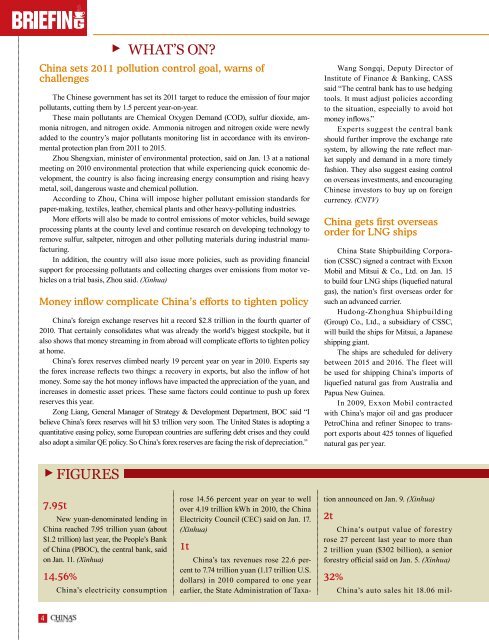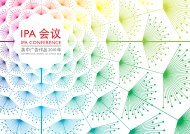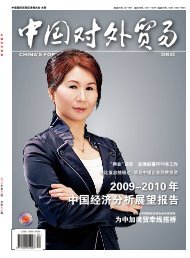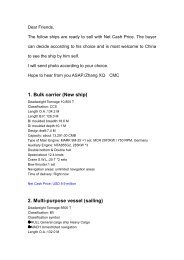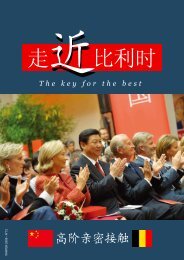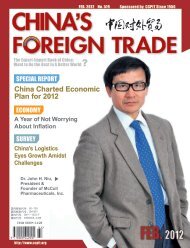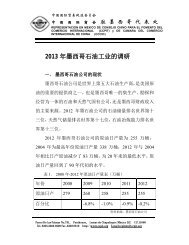You also want an ePaper? Increase the reach of your titles
YUMPU automatically turns print PDFs into web optimized ePapers that Google loves.
What’s on?<br />
China sets 2011 pollution control goal, warns of<br />
challenges<br />
The Chinese government has set its 2011 target to reduce the emission of four major<br />
pollutants, cutting them by 1.5 percent year-on-year.<br />
These main pollutants are Chemical Oxygen Demand (COD), sulfur dioxide, ammonia<br />
nitrogen, and nitrogen oxide. Ammonia nitrogen and nitrogen oxide were newly<br />
added to the country’s major pollutants monitoring list in accordance with its environmental<br />
protection plan from 2011 to 2015.<br />
Zhou Shengxian, minister of environmental protection, said on Jan. 13 at a national<br />
meeting on 2010 environmental protection that while experiencing quick economic development,<br />
the country is also facing increasing energy consumption and rising heavy<br />
metal, soil, dangerous waste and chemical pollution.<br />
According to Zhou, China will impose higher pollutant emission standards for<br />
paper-making, textiles, leather, chemical plants and other heavy-polluting industries.<br />
More efforts will also be made to control emissions of motor vehicles, build sewage<br />
processing plants at the county level and continue research on developing technology to<br />
remove sulfur, saltpeter, nitrogen and other polluting materials during industrial manufacturing.<br />
In addition, the country will also issue more policies, such as providing financial<br />
support for processing pollutants and collecting charges over emissions from motor vehicles<br />
on a trial basis, Zhou said. (Xinhua)<br />
Money inflow complicate China’s efforts to tighten policy<br />
China’s foreign exchange reserves hit a record $2.8 trillion in the fourth quarter of<br />
2010. That certainly consolidates what was already the world’s biggest stockpile, but it<br />
also shows that money streaming in from abroad will complicate efforts to tighten policy<br />
at home.<br />
China’s forex reserves climbed nearly 19 percent year on year in 2010. Experts say<br />
the forex increase reflects two things: a recovery in exports, but also the inflow of hot<br />
money. Some say the hot money inflows have impacted the appreciation of the yuan, and<br />
increases in domestic asset prices. These same factors could continue to push up forex<br />
reserves this year.<br />
Zong Liang, General Manager of Strategy & Development Department, BOC said “I<br />
believe China’s forex reserves will hit $3 trillion very soon. The United States is adopting a<br />
quantitative easing policy, some European countries are suffering debt crises and they could<br />
also adopt a similar QE policy. So China’s forex reserves are facing the risk of depreciation.”<br />
Wang Songqi, Deputy Director of<br />
Institute of Finance & Banking, CASS<br />
said “The central bank has to use hedging<br />
tools. It must adjust policies according<br />
to the situation, especially to avoid hot<br />
money inflows.”<br />
Experts suggest the central bank<br />
should further improve the exchange rate<br />
system, by allowing the rate reflect market<br />
supply and demand in a more timely<br />
fashion. They also suggest easing control<br />
on overseas investments, and encouraging<br />
Chinese investors to buy up on foreign<br />
currency. (CNTV)<br />
China gets first overseas<br />
order for LNG ships<br />
China State Shipbuilding Corporation<br />
(CSSC) signed a contract with Exxon<br />
Mobil and Mitsui & Co., Ltd. on Jan. 15<br />
to build four LNG ships (liquefied natural<br />
gas), the nation’s first overseas order for<br />
such an advanced carrier.<br />
Hudong-Zhonghua Shipbuilding<br />
(Group) Co., Ltd., a subsidiary of CSSC,<br />
will build the ships for Mitsui, a Japanese<br />
shipping giant.<br />
The ships are scheduled for delivery<br />
between 2015 and 2016. The fleet will<br />
be used for shipping China’s imports of<br />
liquefied natural gas from Australia and<br />
Papua New Guinea.<br />
In 2009, Exxon Mobil contracted<br />
with China’s major oil and gas producer<br />
PetroChina and refiner Sinopec to transport<br />
exports about 425 tonnes of liquefied<br />
natural gas per year.<br />
7.95t<br />
Figures<br />
New yuan-denominated lending in<br />
China reached 7.95 trillion yuan (about<br />
$1.2 trillion) last year, the People’s Bank<br />
of China (PBOC), the central bank, said<br />
on Jan. 11. (Xinhua)<br />
14.56%<br />
China’s electricity consumption<br />
rose 14.56 percent year on year to well<br />
over 4.19 trillion kWh in 2010, the China<br />
Electricity Council (CEC) said on Jan. 17.<br />
(Xinhua)<br />
1t<br />
China’s tax revenues rose 22.6 percent<br />
to 7.74 trillion yuan (1.17 trillion U.S.<br />
dollars) in 2010 compared to one year<br />
earlier, the State Administration of Taxation<br />
announced on Jan. 9. (Xinhua)<br />
2t<br />
China’s output value of forestry<br />
rose 27 percent last year to more than<br />
2 trillion yuan ($302 billion), a senior<br />
forestry official said on Jan. 5. (Xinhua)<br />
32%<br />
China’s auto sales hit 18.06 mil-<br />
4


